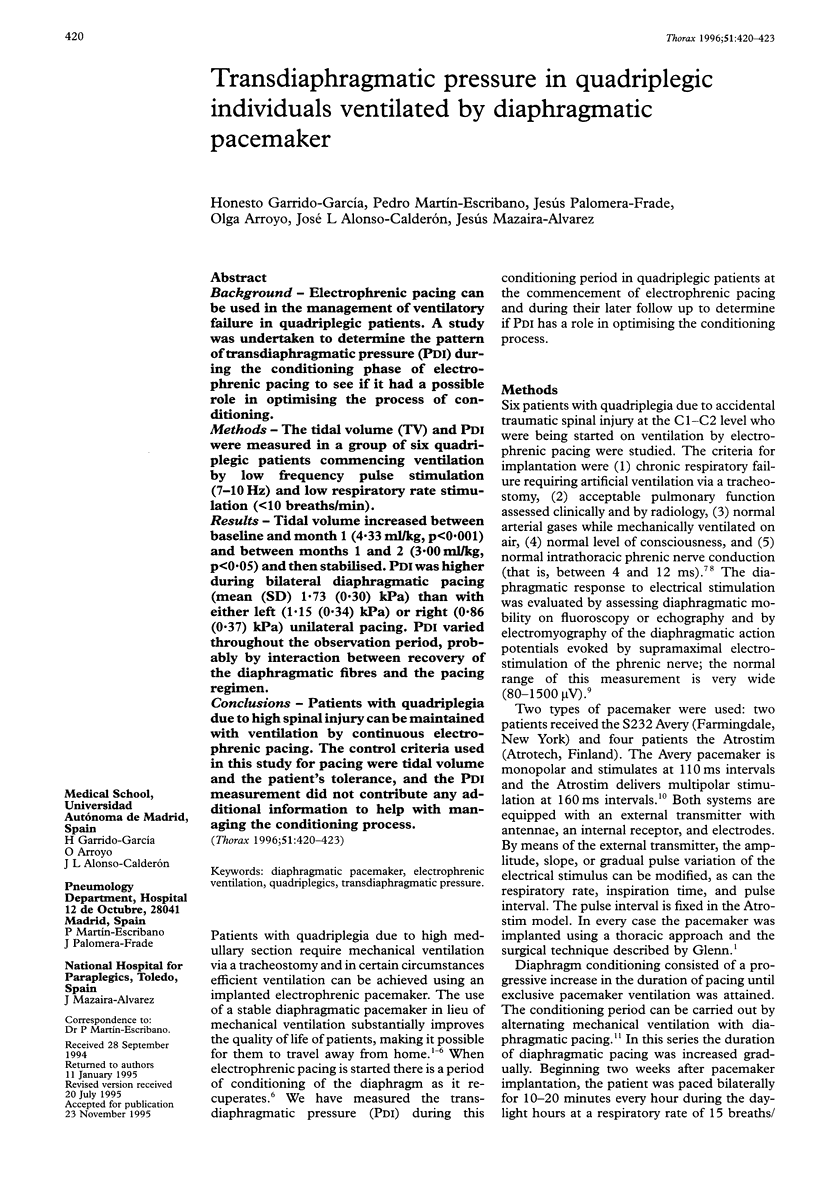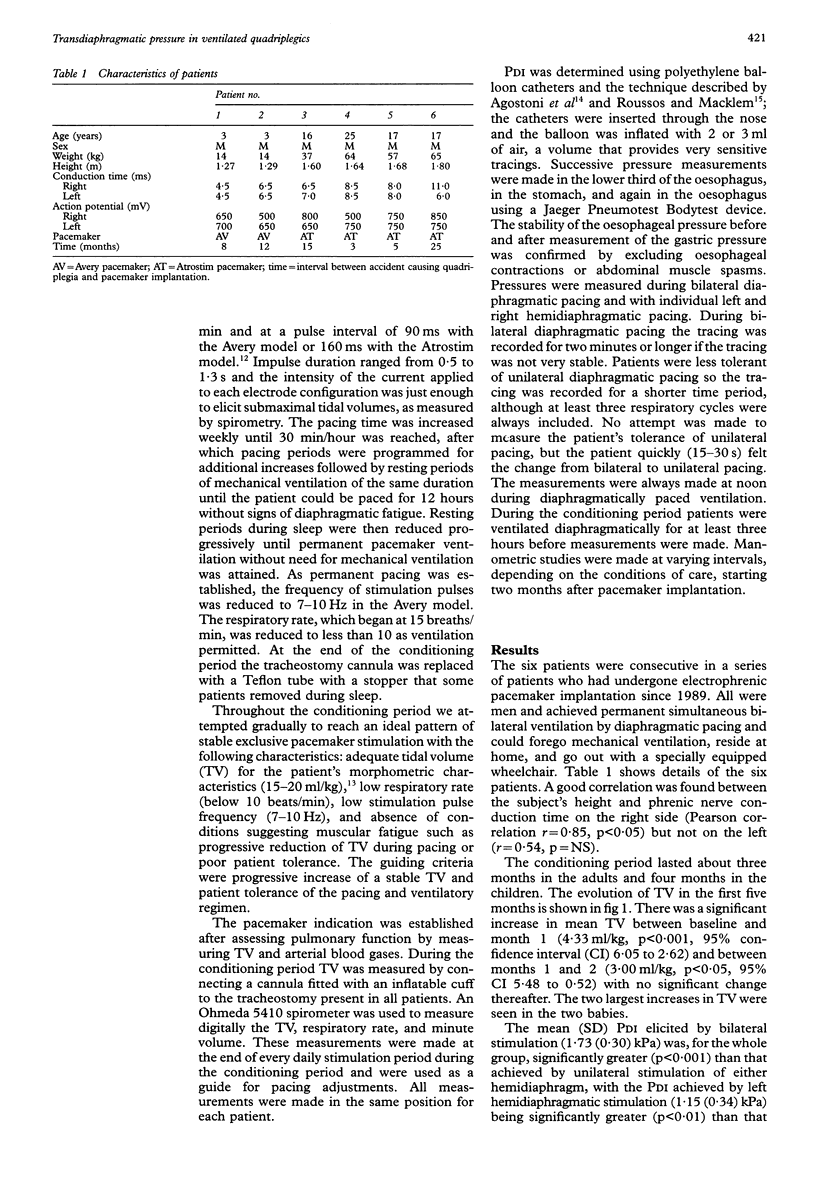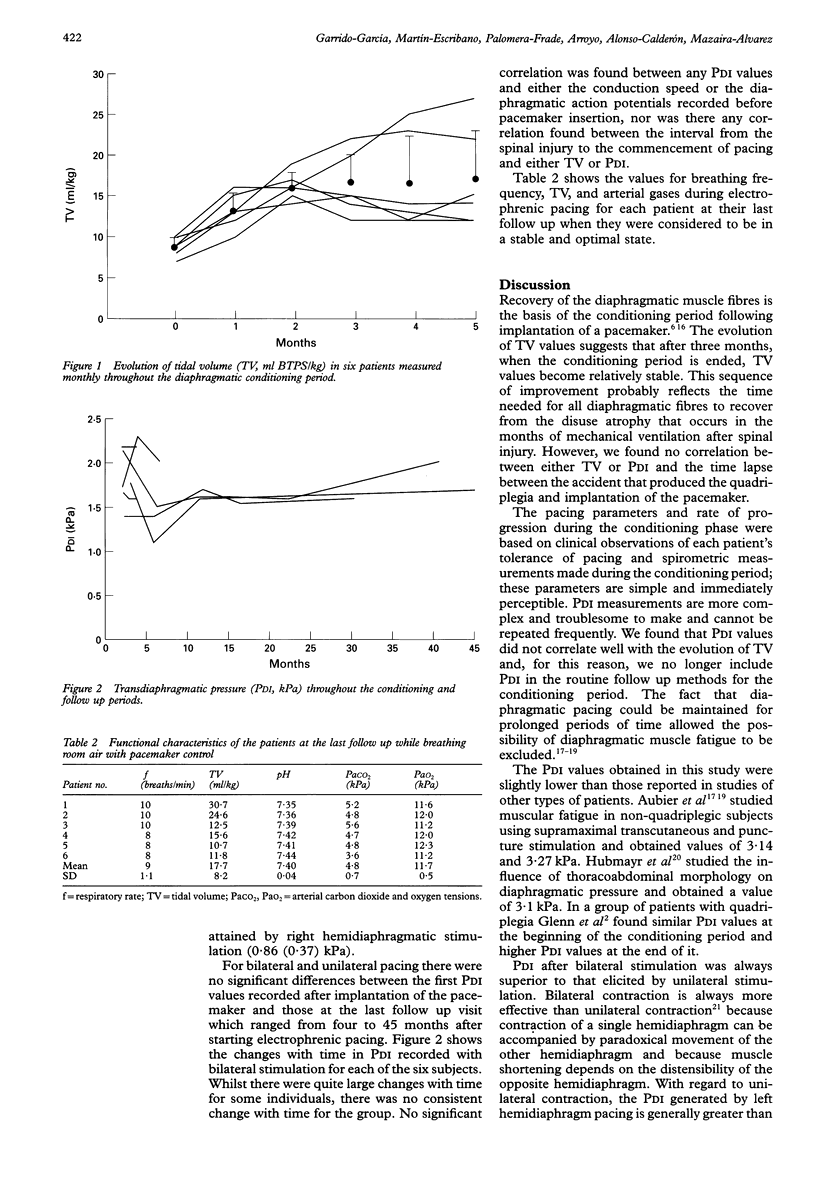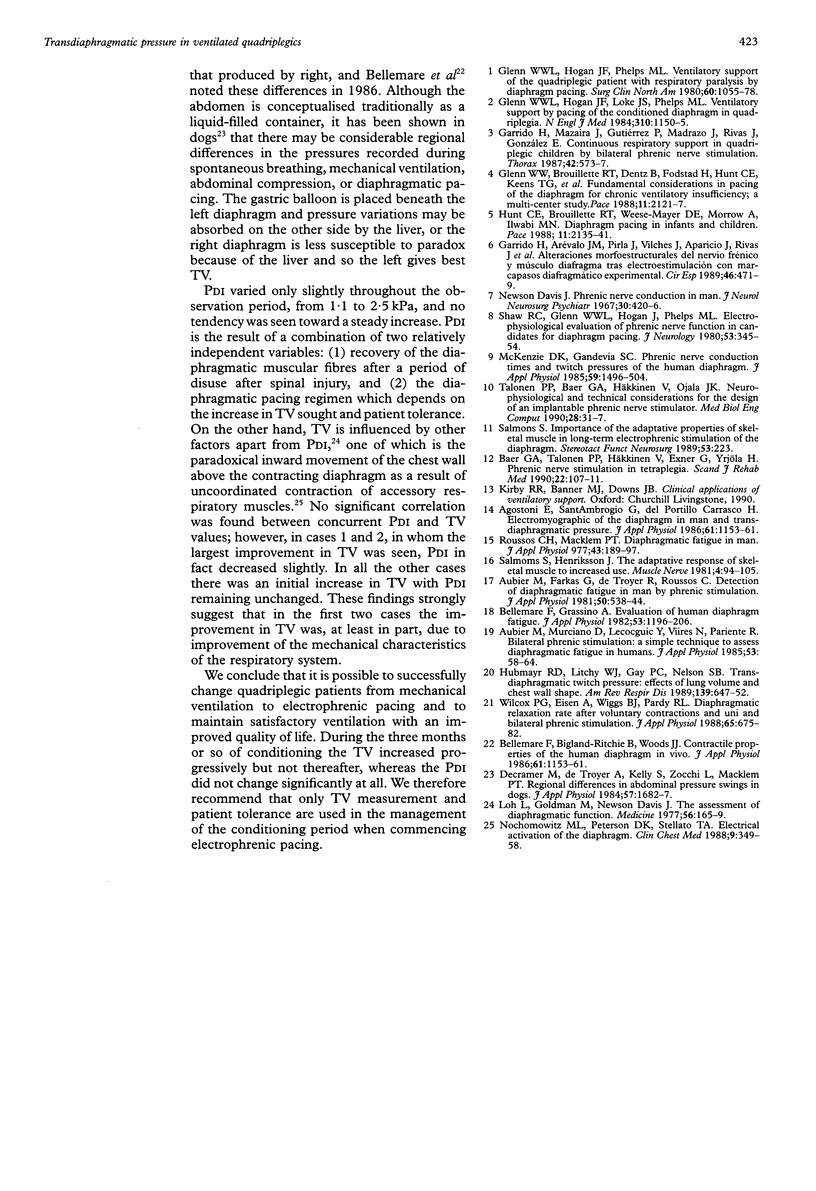Abstract
BACKGROUND: Electrophrenic pacing can be used in the management of ventilatory failure in quadriplegic patients. A study was undertaken to determine the pattern of transdiaphragmatic pressure (PDI) during the conditioning phase of electrophrenic pacing to see if it had a possible role in optimising the process of conditioning. METHODS: The tidal volume (TV) and PDI were measured in a group of six quadriplegic patients commencing ventilation by low frequency pulse stimulation (7-10 Hz) and low respiratory rate stimulation (< 10 breaths/min). RESULTS: Tidal volume increased between baseline and month 1 (4.33 ml/kg, p < 0.001) and between months 1 and 2 (3.00 ml/kg, p < 0.05) and then stabilised. PDI was higher during bilateral diaphragmatic pacing (mean (SD) 1.73 (0.30) kPa) than with either left (1.15 (0.34) kPa) or right (0.86 (0.37) kPa) unilateral pacing. PDI varied throughout the observation period, probably by interaction between recovery of the diaphragmatic fibres and the pacing regimen. CONCLUSIONS: Patients with quadriplegia due to high spinal injury can be maintained with ventilation by continuous electrophrenic pacing. The control criteria used in this study for pacing were tidal volume and the patient's tolerance, and the PDI measurement did not contribute any additional information to help with managing the conditioning process.
Full text
PDF



Selected References
These references are in PubMed. This may not be the complete list of references from this article.
- Aubier M., Murciano D., Lecocguic Y., Viires N., Pariente R. Bilateral phrenic stimulation: a simple technique to assess diaphragmatic fatigue in humans. J Appl Physiol (1985) 1985 Jan;58(1):58–64. doi: 10.1152/jappl.1985.58.1.58. [DOI] [PubMed] [Google Scholar]
- Baer G. A., Talonen P. P., Häkkinen V., Exner G., Yrjölä H. Phrenic nerve stimulation in tetraplegia. A new regimen to condition the diaphragm for full-time respiration. Scand J Rehabil Med. 1990;22(2):107–111. [PubMed] [Google Scholar]
- Bellemare F., Bigland-Ritchie B., Woods J. J. Contractile properties of the human diaphragm in vivo. J Appl Physiol (1985) 1986 Sep;61(3):1153–1161. doi: 10.1152/jappl.1986.61.3.1153. [DOI] [PubMed] [Google Scholar]
- Bellemare F., Grassino A. Evaluation of human diaphragm fatigue. J Appl Physiol Respir Environ Exerc Physiol. 1982 Nov;53(5):1196–1206. doi: 10.1152/jappl.1982.53.5.1196. [DOI] [PubMed] [Google Scholar]
- Davis J. N. Phrenic nerve conduction in man. J Neurol Neurosurg Psychiatry. 1967 Oct;30(5):420–426. doi: 10.1136/jnnp.30.5.420. [DOI] [PMC free article] [PubMed] [Google Scholar]
- Decramer M., De Troyer A., Kelly S., Zocchi L., Macklem P. T. Regional differences in abdominal pressure swings in dogs. J Appl Physiol Respir Environ Exerc Physiol. 1984 Dec;57(6):1682–1687. doi: 10.1152/jappl.1984.57.6.1682. [DOI] [PubMed] [Google Scholar]
- Garrido H., Mazaira J., Gutierrez P., Gonzalez E., Rivas J., Madrazo J. Continuous respiratory support in quadriplegic children by bilateral phrenic nerve stimulation. Thorax. 1987 Aug;42(8):573–577. doi: 10.1136/thx.42.8.573. [DOI] [PMC free article] [PubMed] [Google Scholar]
- Glenn W. W., Brouillette R. T., Dentz B., Fodstad H., Hunt C. E., Keens T. G., Marsh H. M., Pande S., Piepgras D. G., Vanderlinden R. G. Fundamental considerations in pacing of the diaphragm for chronic ventilatory insufficiency: a multi-center study. Pacing Clin Electrophysiol. 1988 Nov;11(11 Pt 2):2121–2127. doi: 10.1111/j.1540-8159.1988.tb06360.x. [DOI] [PubMed] [Google Scholar]
- Glenn W. W., Hogan J. F., Loke J. S., Ciesielski T. E., Phelps M. L., Rowedder R. Ventilatory support by pacing of the conditioned diaphragm in quadriplegia. N Engl J Med. 1984 May 3;310(18):1150–1155. doi: 10.1056/NEJM198405033101804. [DOI] [PubMed] [Google Scholar]
- Glenn W. W., Hogan J. F., Phelps M. L. Ventilatory support of the quadriplegic patient with respiratory paralysis by diaphragm pacing. Surg Clin North Am. 1980 Oct;60(5):1055–1078. doi: 10.1016/s0039-6109(16)42233-4. [DOI] [PubMed] [Google Scholar]
- Hubmayr R. D., Litchy W. J., Gay P. C., Nelson S. B. Transdiaphragmatic twitch pressure. Effects of lung volume and chest wall shape. Am Rev Respir Dis. 1989 Mar;139(3):647–652. doi: 10.1164/ajrccm/139.3.647. [DOI] [PubMed] [Google Scholar]
- Hunt C. E., Brouillette R. T., Weese-Mayer D. E., Morrow A., Ilbawi M. N. Diaphragm pacing in infants and children. Pacing Clin Electrophysiol. 1988 Nov;11(11 Pt 2):2135–2141. doi: 10.1111/j.1540-8159.1988.tb06362.x. [DOI] [PubMed] [Google Scholar]
- Loh L., Goldman M., Davis J. N. The assessment of diaphragm function. Medicine (Baltimore) 1977 Mar;56(2):165–169. doi: 10.1097/00005792-197703000-00006. [DOI] [PubMed] [Google Scholar]
- McKenzie D. K., Gandevia S. C. Phrenic nerve conduction times and twitch pressures of the human diaphragm. J Appl Physiol (1985) 1985 May;58(5):1496–1504. doi: 10.1152/jappl.1985.58.5.1496. [DOI] [PubMed] [Google Scholar]
- Nochomovitz M. L., Peterson D. K., Stellato T. A. Electrical activation of the diaphragm. Clin Chest Med. 1988 Jun;9(2):349–358. [PubMed] [Google Scholar]
- Salmons S., Henriksson J. The adaptive response of skeletal muscle to increased use. Muscle Nerve. 1981 Mar-Apr;4(2):94–105. doi: 10.1002/mus.880040204. [DOI] [PubMed] [Google Scholar]
- Salmons S. Importance of the adaptive properties of skeletal muscle in long-term electrophrenic stimulation of the diaphragm. Stereotact Funct Neurosurg. 1989;53(4):223–232. doi: 10.1159/000099538. [DOI] [PubMed] [Google Scholar]
- Shaw R. K., Glenn W. W., Hogan J. F., Phelps M. L. Electrophysiological evaluation of phrenic nerve function in candidates for diaphragm pacing. J Neurosurg. 1980 Sep;53(3):345–354. doi: 10.3171/jns.1980.53.3.0345. [DOI] [PubMed] [Google Scholar]
- Talonen P. P., Baer G. A., Häkkinen V., Ojala J. K. Neurophysiological and technical considerations for the design of an implantable phrenic nerve stimulator. Med Biol Eng Comput. 1990 Jan;28(1):31–37. doi: 10.1007/BF02441674. [DOI] [PubMed] [Google Scholar]
- Wilcox P. G., Eisen A., Wiggs B. J., Pardy R. L. Diaphragmatic relaxation rate after voluntary contractions and uni- and bilateral phrenic stimulation. J Appl Physiol (1985) 1988 Aug;65(2):675–682. doi: 10.1152/jappl.1988.65.2.675. [DOI] [PubMed] [Google Scholar]


